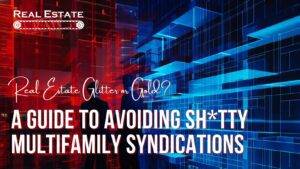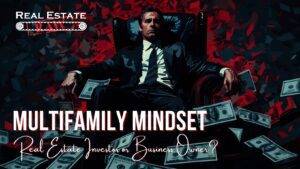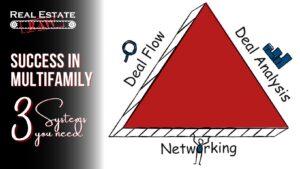Unearthing Diamonds or Digging for Trouble? The Multifamily Value-Add Strategy
Not all that glitters in multifamily is value-add gold. A bunch is just multifamily investment junk. Can you tell the difference?
In this article I will show you the distinction between what has the POTENTIAL to make money and what really doesn’t. I would never tell you that anything is guaranteed to make money, but I will tell you that are plenty of things that are guaranteed to LOSE IT!
If you are investing directly into real estate as a general partner (GP) or whether you are investing passively in a deal as a limited partner (LP) this article will help you to understand what has a higher potential to make money (and lose it) from the perspective of the physical building and the renovation of it. What I call Sticks, Bricks, and Mud.
I have written other articles HERE that explain the process of analyzing a multifamily investment from other perspectives such as the income and comparable sales approach.
What is Multifamily Value-Add?
In multifamily value-add investing, buyers target undervalued apartment buildings. They unlock the property’s potential by making strategic upgrades and renovations, ultimately boosting its value and rental income.
I have renovated over 1000 units, and I have consulted on, managed, inspected and dealt with thousands more in my twenty years as an owner and operator of multifamily properties. I have been through the 2008 market cycle…You don’t know man, you weren’t there!!
Finding a property that has the potential to increase in value through improved operations or physical renovation is a great strategy but there are several major points to consider when looking at this type of investment.
- Market Analysis
- Type of Value-Add (Physical or Operational)
- Exit Strategy
If you have a solid understanding of these three points you will greatly increase the likelihood of success in your deals. Lets discuss each separately.
Markt Analysis
A sober investigation into a market is the beginning of any good real estate venture. When I use the term “market” most people think “location, location, location”. While the physical city and surrounding area is absolutely the market, timing is too. What I mean is that you not only need to know your city, but you also need to know what economic cycle that area is in. Both can either boost or destroy a value-add strategy in a multifamily investment.
Let’s look at each.
Market
I define a market as the area that produces three deals a week in which to analyze. You need to be analyzing deals on a regular basis to find good ones. I suggest three a week. Therefore your “market” is the area or collection of cities that produces the needed level of deal flow. At least three a week.
Knowing what “type” of market you are in will allow you to accurately identify value-add strategies that will (or won’t be) applicable in that area. If you are in an area that has extremely expensive real estate (low cap rate) you will likely have high appreciation and the value of your buildings will likely increase annually but may not cash flow much. Conversely you may be in an affordable housing market where the cash flow is high, but appreciation may be less. Value-add can be extremely different in each area.
In high appreciation markets a basic value-add strategy would be to buy the lowest level property in the area and renovate it to match the surrounding properties. Once the renovations are completed, sell or refinance for a long-term hold and appreciation.
In an affordable housing area, you don’t want to over renovate the assets. Clean, safe, and affordable is the best value-add strategy here. Find buildings that need cosmetic repair and better management and solve that problem while not overestimating rent growth.
The main issue comes when a buyer misaligns the market with the value-add strategy such as spending too much renovating the interior of an apartment but not actually getting the rent they projected to get. The rent that they get for the renovated units does not justify more renovations and the project stalls out.
Expecting too much cash flow from newer assets is also a common value-add mistake. Newer buildings can make great investments but typically take longer to produce a net cash gain as this is usually done by refinancing or selling in the future while producing little cash flow in the interim.
Here is a basic guideline for choosing a market. These are simply suggestions, and each market will have its exceptions.
- Population growth (for the previous twenty years)
- Thirty percent growth for cities with a population of 250,000 or less.
- Twenty percent growth for cities with a population of 250,000 to 1,000,000.
- Fifteen percent growth for cities with a population of 1,000,000 to 2,000,000.
- Ten percent growth for cities with a population of 2,000,000 or more.
- Median household income growth
- Thirty percent or more growth of the median household income over the last fifteen years.
- Crime
- Crime should be declining or at least holding steady in the area.
- Job growth
- Two percent or more annualized job growth in the city if the population is less than 1,000,000.
- One and a half percent or more annualized job growth in the city if the population is more than 1,000,000.
- Median household income
- The median household income should be over $50,000 a year for the area.
- Median rent
- The average rent for the city should be no less than $700 a month.
For current data, visit the Department of Numbers (www.deptofnumbers.com) and the City-Data (www.city-data.com) websites.
Market Cycles
There are four business/economic cycles. The Expansion, Peak, Recession, and Trough Cycles. Here is a basic diagram.
I cover market cycles fully in my article HERE. The reason I mention it here is not so you can try and “time the market”, but to give you an understanding of what type of value-add strategies to use in each segment of the total economic cycle. Each full cycle Peak to Peak or Trough to Trough is usually about 10-12 years long. The market cycle beginning in 2008 lasted well over ten years.
Here is each cycle with a few tips for value-add for each.
- The Expansion Cycle
- Heavy renovations now. The market at values are rising and interest rates likely to be falling. Get ready to sell or refinance in 2-3 years for big gains.
- The Peak
- Values are peaking here so no more large renovations. Value-add here is to buy a quality asset with long-term debt. Plan to sell or refinance in 5 years.
- The Recession
- This does not mean a literal economic recession as the title might suggest. Prices are falling here as interest rates are on the rise. Rents are likely level or declining now. NO renovations here! Value-add will most often be in the form of correcting poor operations and management. Find valuation through operation not renovation in this cycle.
- The Trough
- Buy everything. Creative Financing techniques like Seller Financing and Master Lease Options will be great from of value-add in this cycle. Debt will be expensive and difficult for non-preforming, distressed multifamily deals. Buy properties that will be renovated in 2-3 years to maximize value in the next cycle.
As you can see, each cycle can have its unique strategy. This info is just a guide as you may find individual deals that buck this system. The trick is to know WHEN to break the rules. If you think that every deal you do is “outside” of this, you’re simply gambling.
Want to discuss the value-add strategies that are working in today’s market? Go HERE!
Value vs. Price
The best value-add strategy I have ever used was…paying the right price. What you pay for something and what something is worth are two separate concepts.
Money is made when the value of something is known, and money is lost when it is not.
A good deal is when you pay less for an asset than it is worth. The catch with the value-add strategy for multifamily is to identify a value-add property without paying the seller NOW for the POTENTIAL to make money someday. It’s not a value-add if you pay the seller for all the future value now. That’s value-minus.
Knowing the future value of an asset while paying a discount today is the key to successfully using a multifamily value-add strategy. Pay close attention to what market cycle you are currently in and adjust your purchase and exit strategies accordingly and you are likely to be the value-add business for a long time.
Want to take a deeper dive into underwriting value-add multifamily deals?
Join me for a FREE LIVE webinar where I will break down the underwriting/value-add process step-by-step. You’ll learn how to analyze value-add deals like a pro and make data-driven decisions to maximize profits and minimize risk.
Here’s what you’ll get on the webinar:
- Advanced value-add underwriting techniquesnot covered in this article (e.g., OpEx vs. CapEx, renovating with creative financing).
- Real-world case studiesto see how the concepts are applied in practice.
- A FREE Excel-based multifamily underwriting templateto streamline your analysis (for webinar registrants only).
Reserve your spot for the FREE webinar today! [Space is limited, so don’t miss out!]
Register HERE!
P.S. Even if you’re a complete beginner, this webinar will equip you with the knowledge and tools you need to get started finding value-add deals today.
Best of Luck!
Bill Ham


































